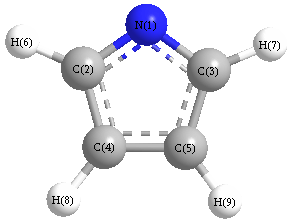Vibrational Frequencies calculated at TPSSh/6-31G**
| Mode Number |
Symmetry |
Frequency
(cm-1) |
Scaled Frequency
(cm-1) |
IR Intensities
(km mol-1) |
Raman Act
(Å4/u) |
Dep P |
Dep U |
|---|
| 1 |
A1 |
3269 |
3134 |
3.86 |
|
|
|
| 2 |
A1 |
3217 |
3084 |
5.00 |
|
|
|
| 3 |
A1 |
1576 |
1511 |
0.82 |
|
|
|
| 4 |
A1 |
1454 |
1394 |
23.25 |
|
|
|
| 5 |
A1 |
1205 |
1155 |
3.03 |
|
|
|
| 6 |
A1 |
1102 |
1056 |
35.86 |
|
|
|
| 7 |
A1 |
1054 |
1010 |
0.22 |
|
|
|
| 8 |
A1 |
867 |
832 |
11.73 |
|
|
|
| 9 |
A2 |
901 |
864 |
0.00 |
|
|
|
| 10 |
A2 |
818 |
784 |
0.00 |
|
|
|
| 11 |
A2 |
485 |
465 |
0.00 |
|
|
|
| 12 |
B1 |
829 |
794 |
1.12 |
|
|
|
| 13 |
B1 |
716 |
687 |
51.89 |
|
|
|
| 14 |
B1 |
536 |
514 |
21.05 |
|
|
|
| 15 |
B2 |
3248 |
3114 |
9.68 |
|
|
|
| 16 |
B2 |
3213 |
3080 |
25.85 |
|
|
|
| 17 |
B2 |
1368 |
1311 |
44.57 |
|
|
|
| 18 |
B2 |
1305 |
1251 |
0.01 |
|
|
|
| 19 |
B2 |
1077 |
1032 |
8.45 |
|
|
|
| 20 |
B2 |
941 |
902 |
0.04 |
|
|
|
| 21 |
B2 |
671 |
643 |
4.22 |
|
|
|
Unscaled Zero Point Vibrational Energy (zpe) 14924.2 cm
-1
Scaled (by 0.9587) Zero Point Vibrational Energy (zpe) 14307.9 cm
-1
See section
III.C.1 List or set vibrational scaling factors
to change the scale factors used here.
See section
III.C.2
Calculate a vibrational scaling factor for a given set of molecules
to determine the least squares best scaling factor.
Charges, Dipole, Quadrupole and Polarizability
Charges from optimized geometry at TPSSh/6-31G**
Charges (e)
| Number |
Element |
Mulliken |
CHELPG |
AIM |
ESP |
| 1 |
N |
-0.441 |
|
|
|
| 2 |
C |
0.094 |
|
|
|
| 3 |
C |
0.094 |
|
|
|
| 4 |
C |
-0.142 |
|
|
|
| 5 |
C |
-0.142 |
|
|
|
| 6 |
H |
0.137 |
|
|
|
| 7 |
H |
0.137 |
|
|
|
| 8 |
H |
0.131 |
|
|
|
| 9 |
H |
0.131 |
|
|
|
Electric dipole moments
Electric dipole components in Debye
(What's a Debye? See section
VII.A.3)
| |
x |
y |
z |
Total |
| |
0.000 |
0.000 |
-2.321 |
2.321 |
| CHELPG |
|
|
|
|
| AIM |
|
|
|
|
| ESP |
|
|
|
|
Electric Quadrupole moment
Quadrupole components in D Å
Polarizabilities
Components of the polarizability tensor.
Units are
Å
3 (Angstrom cubed)
Change units.
| |
x |
y |
z |
| x |
2.703 |
0.000 |
0.000 |
| y |
0.000 |
8.261 |
0.000 |
| z |
0.000 |
0.000 |
6.932 |
<r2> (average value of r
2) Å
2
| <r2> |
81.941 |
| (<r2>)1/2 |
9.052 |
